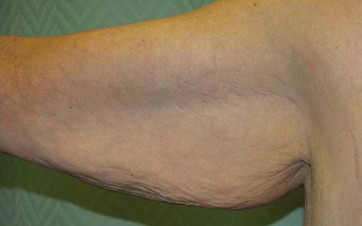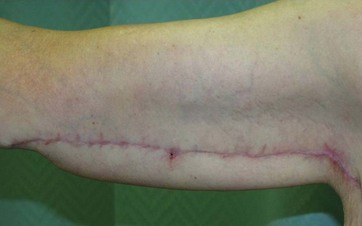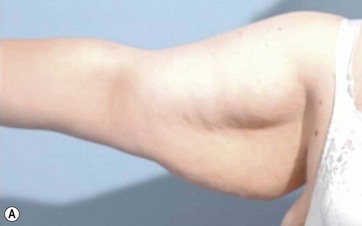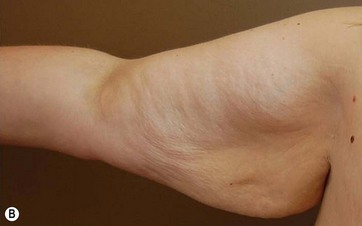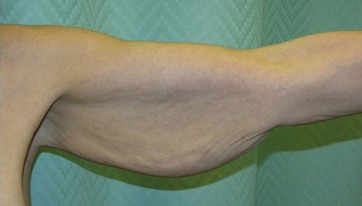Chapter 3 Brachioplasty with bicipital groove scar
• The patient must be willing to accept the possibility of visible and even poor scarring.
• Improvement in contour must be significant to justify the visible scarring.
• The arm must be adequately deflated before brachioplasty.
• If there is laxity on the lateral chest wall consideration should be given to extending the excision to the inframammary fold.
• In massive weight loss patients, a Z plasty is not usually necessary in the axilla.
Introduction
The increase in obesity in the United States of America and the concurrent meteoric rise in bariatric surgery has led to an increasing interest and popularity of the brachioplasty procedure. Statistics from the American Society of Plastic Surgeons have borne this out, with an increase in the number of brachioplasties from 2516 in 1997 to 16 102 in 2009.1 Massive weight loss patients make up the bulk of brachioplasty patients. As is true in all parts of the body after massive weight loss, the deformities can be highly varied. Some patients do not have much loss of fat from their arms and require debulking before a formal brachioplasty. Other patients have truly deflated arms and describe “pinching” of the loose skin as it is folded into their clothing.
Esthetic brachioplasty was first described by Correa-Inturraspe and Frenandez2 in 1954. Lockwood (1995)3 described the superficial fascial repair of the arm, but as was the case with his work on lower body lifts, most of his patients were complaining of aging and not massive weight loss. However, until the avalanche of massive weight loss patients entered the plastic surgeon’s office there was little interest in the procedure. That said, many plastic surgeons were still reluctant to perform the procedure due to concerns about scars and axillary contractures. The massive weight loss patients have helped change the plastic surgeons’ minds, focusing the improvement of contour with fewer concerns about scars. Plastic surgeons of course, however, continue to try and improve the scars and argue about scar placement. Some plastic surgeons advocate a scar along the most inferior point of the upper arm4 and others have recommended a sinusoidal type of scar placement.5 At polls taken during plastic surgery meetings the most common scar placement has been reported to be within the bicipital groove (Downey S, personal communication). A survey taken of the general public, plastic surgeons and patients confirmed that the most acceptable position of a scar is along the bicipital groove.6 Many plastic surgeons are now continuing the excision proximally into the axillary area7 and in some massive weight loss patients this excision may be extended down the trunk to the inframammary fold.8,9
Preoperative Preparation
The evaluation of patients presenting for brachioplasty involves consideration of how much residual fat is present and the looseness of the skin. One of the first considerations will be whether there is enough laxity to justify a scar from elbow to axilla or longer (Figs 3.1 and 3.2). Patients with minimal looseness may benefit from looking at pictures of patients who have undergone brachioplasty in order to understand the length of the scars and the typical “rope-like” appearance of the scar near the elbow. Some clinicians have advocated drawing the proposed scar on the patient so they can live with the proposed scar for a while and see if it is something that they can accept.
The second type of patient is the opposite – the patient who has had minimal deflation of their arms. These patients will not have a satisfactory result from a brachioplasty without deflation. Attempts to perform a brachioplasty will lead to an arm still very full, but now with the addition of a long scar. There are two schools of thought: liposuction at the time of brachioplasty, and liposuction or deflation followed at a later interval (usually several months) by the formal excision. In many cases the arms are not the patient’s first priority and the deflation can be combined with the first excisional procedure the patient is undergoing (for example, an abdominoplasty) and then the formal brachioplasty could occur at a later time. Often this is a very acceptable plan for the patient as the deflation will allow the patient to wear more normal clothes or clothes that better fit their torso even though the arms are still loose (Fig. 3.3).
The third type of patient has adequate deflation and enough looseness that they will have enough improvement in contour to justify the scar. Evaluation of these patients needs to include the skin of the forearm as well as the excess and laxity of the lateral chest wall. Rotation of the skin/fat flap in an upwards and inwards manner will somewhat improve the loose skin of the forearm, but not significantly. This upward/inward rotation will leave an excess or dog-ear in the axilla. To excise this dog-ear and to give patients an even better outcome the excess can be excised down to the inframammary fold. Patients often consider this a real benefit as they object to the “bra roll” fat.9 This fat or roll may not be visible to the plastic surgeon unless the patient has on or puts on their bra during the consultation. Even male weight loss patients may benefit from this extension down the chest wall as many male shirts now are more body revealing and a smooth contour in this area is desirable. Even in these patients who will have a significant improvement in contour it is advisable to show them pictures of brachioplasty patients so that they are aware of the length of the scars, the scar position, and the length of time that it will take the scars to mature.
Preoperative consultation not only should include discussions as to the improvement to be seen in the arms but also the limits. Many patients are concerned about the lower arm. Often the lower arm exhibits laxity but not enough looseness to justify extending the incision below the elbow. Many patients who have experienced extreme weight loss will always have more laxity to their skin and no surgical procedure to date will improve this. The scar of a brachioplasty needs to be discussed in detail with patients. In general, the scar closest to the axilla will do the best while the scar closest to the elbow will do the worst (Figs 3.4 and 3.5). This is, of course, opposite to what the patient (and surgeon) wishes. Although the scar close to the elbow will eventually settle down and become flatter, it is often a long process and may require not only a lot time but topical therapy such as taping or even steroid injections. In some cases the scars are thick and wide (Fig. 3.6).
< div class='tao-gold-member'>
Stay updated, free articles. Join our Telegram channel

Full access? Get Clinical Tree


